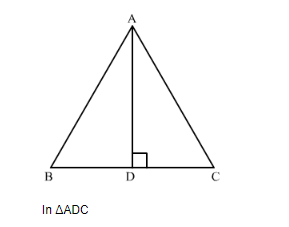If $\triangle \mathrm{ABC}$ is an equilateral triangle such that $\mathrm{AD} \perp \mathrm{BC}$, then $\mathrm{AD}^{2}=$
(a) $32 \mathrm{DC} 2$
(b) $2 \mathrm{DC}^{2}$
(c) $3 \mathrm{CD}^{2}$
(d) $4 \mathrm{DC}^{2}$
Given: In an equilateral $\triangle \mathrm{ABC}, \mathrm{AD} \perp \mathrm{BC}$.
Since $\mathrm{AD} \perp \mathrm{BC}, \mathrm{BD}=\mathrm{CD}=\mathrm{BC} 2$
Applying Pythagoras theorem,

$\mathrm{AC}^{2}=\mathrm{AD}^{2}+\mathrm{DC}^{2}$
$\mathrm{BC}^{2}=\mathrm{AD}^{2}+\mathrm{DC}^{2}($ Since $\mathrm{AC}=\mathrm{BC})$
$(2 \mathrm{DC})^{2}=\mathrm{AD}^{2}+\mathrm{DC}^{2}($ Since $\mathrm{BC}=2 \mathrm{DC})$
$4 D C^{2}=A D^{2}+D C^{2}$
$3 \mathrm{DC}^{2}=\mathrm{AD}^{2}$
$3 \mathrm{CD}^{2}=\mathrm{AD}^{2}$
We got the result as (c)
Click here to get exam-ready with eSaral
For making your preparation journey smoother of JEE, NEET and Class 8 to 10, grab our app now.
